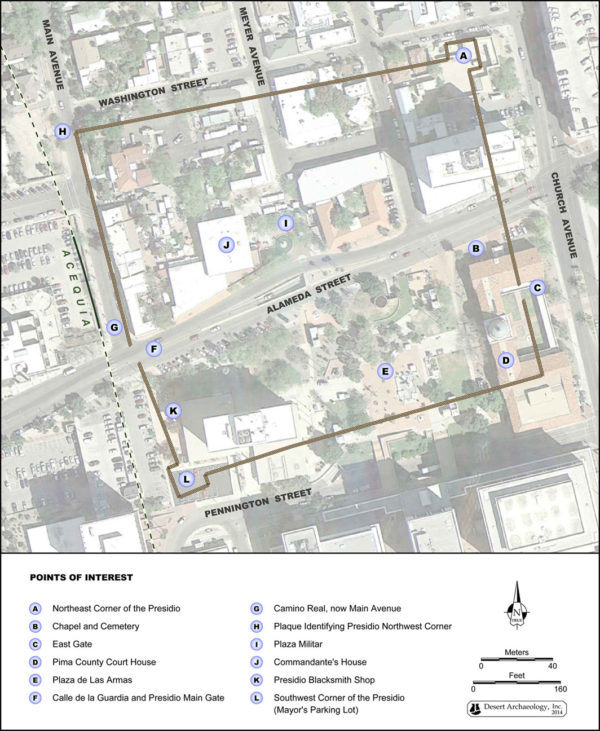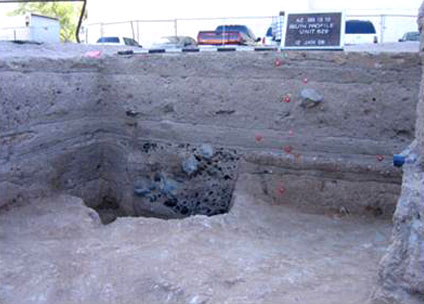
Suppertime at the Presidio San Agustín del Tucson
Historical archaeologist Homer Thiel starts off the fall/winter feasting season with a look at the foods prepared by residents of Tucson during the Presidio era.
It’s that time of year when residents of Tucson sit down for big meals at various holidays. We go to our local supermarkets or farmers markets to purchase a variety of foodstuffs, most of which are brought into Tucson from great distances. This was not an option for the people living in our community several hundred years ago, who mostly ate foods grown nearby. What did the people living in the Tucson Basin during the Presidio era—the soldiers, civilians, O’odham, and Apache—eat? Surviving documents and archaeological finds can help us learn about our community’s long food history.
The location for the Presidio San Agustín del Tucson was selected by the Spanish in August 1775, and the following year 65 soldiers from the Tubac Presidio moved north and began construction of the new fortress.

The original Presidio wall alignments and points of interest overlain on an aerial photograph of modern Tucson (image by Catherine Gilman).
The adobe walls and towers were completed in 1783, and the fort remained in use until 1856. It was rapidly dismantled after the Mexican military left the fort and settlers from the eastern United States and from Sonora, Mexico moved into the area. The Mexican military loaded up the civil, military, and church records and took them to Imuris, Sonora. Most have not been seen since, and have probably been lost forever. This makes historical research somewhat difficult. Luckily, archaeology can help fill in some of the lost information.
One reason the fort was built on the terrace overlooking the Santa Cruz River floodplain was because that river flowed year-round in this area. Native Americans at the original Schook-shon had been growing crops of maize, beans, and squash for thousands of years in irrigated fields along the river. The residents of the San Agustín Mission, located at the base of Sentinel Peak (also called “A” Mountain), were growing these crops as well as watermelons when Father Eusebio Kino visited the area in the 1690s. Kino gave the villagers wheat, barley, peaches, quince, and other Old World crops, as well as domesticated animals—cattle, sheep, goats, and horses.
Few Presidio era documents describe foods. We know from an 1804 report that 2,800 bushels of wheat, 800 bushels of maize, and 300 bushels of beans and other vegetables were grown in Tucson in the previous year. Two hundred men were engaged in agriculture. Commercial chocolate was imported into the community, and we know from Father Arriquibar’s 1820 will that he ordered jars of wine for use in religious ceremonies. There were 3,500 head of cattle and 2,600 head of sheep. In 1803, 300 cattle were slaughtered, of which 130 were given to the peaceful Apache who lived northwest of the Presidio. Two hundred sheep were also slaughtered (most sheep were probably raised for their hides).
The Mormon Battalion, a group of Latter Day Saints soldiers, marched from St. Louis to San Diego in 1846. They stopped in Tucson in December 1846 and at least five of the men wrote descriptions of the community. They recorded that wheat, cornmeal, beans, salt, quince, hogs, and chickens were available. Three years later, 49ers on their way to California reported wheat flour, tortillas, pumpkins, rice, peppers, maize, quince, beans, sugar, sheep, goats, cattle, and cow’s milk.
Archaeological evidence supports the surviving documents. Beef was the most common meat eaten at the fort. Cattle carcasses were chopped apart using cleavers or axes. Sheep (and perhaps goats) were butchered in similar ways.
Most of the meat was consumed fresh, cooked in in-ground ovens or boiled in Native American pots. Some was air-dried and carried by soldiers on expeditions away from the fort.

An in-ground roasting pit, used to cook meat, found at the Presidio San Agustín del Tucson site (photo by Homer Thiel).
Chickens were also raised, probably for their eggs. Wild animals are very uncommon and the residents of the Presidio and the San Agustin Mission do not appear to have done much hunting. This may be a result of nearby Apache warriors making hunting dangerous, or a cultural preference for beef and mutton.
Plant remains suggest that wheat and maize were commonly consumed. These were ground into flour either using a mano and metate or—by the 1840s—donkey-powered grain mills. Tortillas were made using ceramic comal plates and bread was baked in adobe hornos (ovens).
Seeds from beans, peppers, apple or quince, and squash or pumpkin were found Presidio era pits. People dried pumpkin strips and beans for use during the winter months, and gathered some wild plants, including cactus fruit and, perhaps, purslane.
The most detailed description of a meal eaten at the Presidio is one James G. Bell wrote in his diary on December 24, 1854, after having dinner at the Comandante’s house: “Our first dish was rice cooked with some ingridients to make it palatable, and Chili Verde (green pepper) in a separate dish, but to eat to-gether; second was Beef, Squash, Quinces, whole Peppers, Green Beans, cooked separately, but all, on the table in one dish; third, dried beans, and Pepper to eat with them; fourth, desert, boiled flour Pudding with almonds in it, and Peach Marmalade for sauce. A large glass tumbler with a pitcher of water composed our drinking, table-ware. The thin and well baked flour Tortilla common to this country, accompanied the meal…”

A Sobaipuri Pima (Native American) bean pot, used to cook soups and stews, from the Presidio San Agustín del Tucson site (photo by Homer Thiel).
Visitors to the monthly Living History events at the Presidio San Agustín del Tucson Museum, at 196 N. Court Avenue, can sample tortillas, bread baked in an horno, and quince jam made from the tree growing in the park. The next Living History is a Luminaria Event on December 9, 2017, running from 3 to 8 PM.





